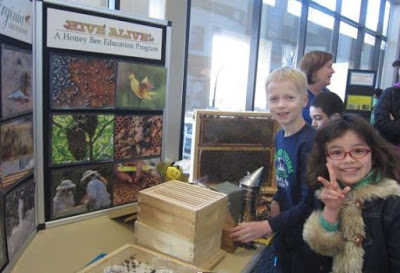Environmental education is a big deal at Belvedere Elementary School
 |
| Belvedere students at the School Environmental Action Showcase at George Mason University April 6. [Belvedere ES] |
Belvedere Elementary School is taking the “going green” concept to the next level. In addition to schoolwide recycling and cafeteria composting, students grow fresh vegetables for a food pantry and engage in “food rescue,” in which unopened food and beverages are taken to a local shelter.
“I’m just so impressed by how committed the school is to instilling a sense of environmental stewardship in these kids and how incredibly enthusiastic these kids are about all the programs,” says Laura Noble, who volunteers at the school with environmental educator Stacey Evers.
The school also has an outdoor classroom and a tree seedling nursery, and the Belvedere community cleaned up and created a trail through Belvedere Park.
These projects are coordinated by the student led Green Team, and much of the funding for these projects comes from a long list of business sponsors, county agencies, and nonprofits. There’s also a third-grade Seed Savers Club and a fourth and fifth-grade Waste Watchers group that manages school waste and teachers other students decomposition and composting.
In November Belvedere earned the Eco-Schools Green Flag award from the international Foundation for Environmental Education, which recognizes schools that engage students in their school’s environmental policies. The program is sponsored in the U.S. by the National Wildlife Federation.
To meet the Green Flag requirements, the Belvedere community, led by the Green Team and a parent-staff Eco-Committee, expanded native plant/pollinator gardens and wildlife habitat on the school grounds, explored energy consumption and conservation in the Cool Schools Challenge, increased the biodiversity of plant life, and explored the role of plants in stormwater management.


I wonder if a limited number of community members could avail themselves of the programs like composting and donation of food. How great if many schools and businesses could follow Belvedere's lead. They could create a blueprint & make presentations (in person, via Power Point, CD or download from You Tube) to potential schools/office buildings/organizations.